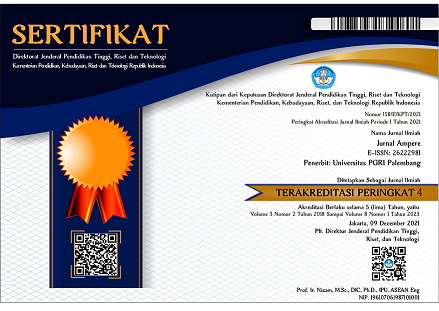Pemodelan Efisiensi Energi Panel Surya Berdasarkan Variasi Suhu Dengan Algoritma Random Forest
DOI:
https://doi.org/10.31851/ampere.v9i2.16836Keywords:
Temperature Efficiency, Random Forest, Software Rstudio, MSE, RMSEAbstract
When temperature increases, energy efficiency tends to decrease. This is because the materials in solar panels, especially photovoltaic cells, have characteristics that make them less efficient at converting solar energy into electrical energy when temperatures rise. By using the random forest research method and Rstudio software to help analyze it can be concluded that the temperature variation that has the most influence on power efficiency is light intensity with a contribution of 19%, then air temperature with 18%, humidity with 17.5%, wind speed with 14%. 5% and finally panel temperature with a contribution of 13%. This contribution is the contribution to the power produced by the effect of temperature on the power produced. at 10.13 the highest power was obtained, where the power produced was 164.48 Watts. With a light intensity of 431.44 cd (candela), air temperature of 41.9°C, humidity of 49.4%, wind speed of 0.2 m/s, and panel temperature of 35 °C
References
A. Makkulau, S. Samsurizal, and S. Kevin, “Karakteristik Temperatur Pada Permukaan Sel Surya Polycrystalline Terhadap Efektifitas Daya Keluaran Pembangkit Listrik Tenaga Surya,” Sutet, vol. 10, no. 2, pp. 69–78, 2020, doi: 10.33322/sutet.v10i2.1291.
H. P. D. Edwin, W. A. Jhon, T. Ambros, and P. Aris, “Pengaruh Bayangan Terhadap Output Tegangan Dan Kuat Arus Pada Pembangkit Listrik Tenaga Surya (Plts),” Rotor, vol. 11, no. 2, p. 47, 2018, doi: 10.19184/rotor.v11i2.9343.
J. Indra Bayu, I. Budi Sulistiyawati, and N. Putu Agustini, “Monitoring Pengaruh Suhu Pada Panel Surya Terhadap Performa Keluaran Pembangkit Listrik Tenaga Surya,” J. FORTECH, vol. 4, no. 1, pp. 27–32, 2023, doi: 10.56795/fortech.v4i1.4104.
K. Olcay, S. Giray Tunca, and M. Arif Ozgur, “Forecasting and Performance Analysis of Energy Production in Solar Power Plants Using Long Short-Term Memory (LSTM) and Random Forest Models,” IEEE Access, vol. 12, no. June, pp. 103299–103312, 2024, doi: 10.1109/ACCESS.2024.3432574.
D. E. Myori, R. Mukhaiyar, and E. Fitri, “Sistem Tracking Cahaya Matahari pada Photovoltaic,” INVOTEK J. Inov. Vokasional dan Teknol., vol. 19, no. 1, pp. 9–16, 2019, doi: 10.24036/invotek.v19i1.548.
R. Pratama, “Pengembangan Sistem Akuisisi Data Arus, Tegangan, Daya Dan Temperatur Pada Pembangkit Listrik Tenaga Surya,” J. Edukasi Elektro, vol. 3, no. 2, pp. 55–62, 2020, doi: 10.21831/jee.v3i2.29812.
H. B. Nurjaman and T. Purnama, “Pembangkit Listrik Tenaga Surya (PLTS) Sebagai Solusi Energi Terbarukan Rumah Tangga,” J. Edukasi Elektro, vol. 6, no. 2, pp. 136–142, 2022, doi: 10.21831/jee.v6i2.51617.
A. Azis, M. Rijaluddin Tahfiz, and N. Nurdiana, “Perancangan Sistem Penggerak Panel Surya Pada Pembangkit Listrik Tenaga Surya Mobile Berbasis Arduino,” Electr. J. Rekayasa dan Teknol. Elektro, vol. 17, no. 2, pp. 161–168, 2023, doi: 10.23960/elc.v17n2.2418.
Suriadi and M. Syukri, “Perencanaan Pembangkit Listrik Tenaga Surya (PLTS) Terpadu Menggunakan Software PVSYST Pada Komplek Perumahan di Banda Aceh,” J. Rekayasa Elektr., vol. 9, no. 2, pp. 77–80, 2020.
F. W. Atmojo et al., “Analisis Pemanfaatan Machine Learning Guna Prediksi Indeks,” vol. 9, no. 2, 2024.
Downloads
Published
How to Cite
Issue
Section
License
Copyright (c) 2024 Feby ardianto, Yosi Apriani, Muhammad Alvin Pratama, Eko Ariyanto

This work is licensed under a Creative Commons Attribution-ShareAlike 4.0 International License.

Jurnal Ampere is licensed under a Creative Commons Attribution-ShareAlike 4.0 International License.
Authors who publish with this journal agree to the following terms:
- Authors retain copyright and grant the journal right of first publication with the work simultaneously licensed under a Creative Commons Attribution License that allows others to share the work with an acknowledgement of the work's authorship and initial publication in this journal.
- Authors are able to enter into separate, additional contractual arrangements for the non-exclusive distribution of the journal's published version of the work (e.g., post it to an institutional repository or publish it in a book), with an acknowledgement of its initial publication in this journal.
- Authors are permitted and encouraged to post their work online (e.g., in institutional repositories or on their website) prior to and during the submission process, as it can lead to productive exchanges, as well as earlier and greater citation of published work.





